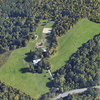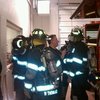Contract signed, feuding continues
VOORHEESVILLE — The village board of trustees and the Voorheesville Area Ambulance Service signed a contract Tuesday, ending months of discord between the two entities. The feuding did not end, however, as members of both groups continued to argue publicly after the board approved the contract with a split vote.
After the vote, VAAS members implored the village board to relinquish its contract with the ambulance and to let the town of New Scotland oversee the squad. Just before the vote, at the village board’s workshop, trustees continued to discuss options for ambulance service if the VAAS dissolves entirely.
“We need to move on”
The village board agreed to a contract submitted to it by VAAS attorney Terence Hannigan. Village Attorney Richard Reilly said that the proposed contract eliminated the village’s request that the service’s assets be turned over to the village if the squad dissolved.
The contract also included stipulations that the VAAS be given 14-day notice of a meeting, and 60 days’ notice for any changes to its agreement.
The village board voted without discussion, with Mayor Robert Conway, Trustee Jack Stevens, and Trustee Brett Hotaling voting in favor of the contract, and trustees David Cardona and Richard Berger voting against it.
At the board’s workshop earlier, Cardona said that the new contract did not include the language for asset distribution, but that it still contained the service’s request for $8,800 for a reserve fund. Cardona said that the village does not have 14-day notice clauses with its other vendors.
“We’re in worse shape now than the original contract,” Cardona said. “I think that’s a mistake if you vote for that. It’s a big mistake.”
“I’m going to vote for the contract,” Stevens said. “I can’t go any further with the liability.”
“We need to move on,” Conway said.
The reserve fund amount has been a point of contention between the village board and the squad for months, with discussion over whether or not the amount would be paid into a new vehicle fund, a roof fund, or a maintenance fund.
Cardona said that the contract called for the $8,800 reserve, while the service was on record as needing $20,000 for its new roof. The real cost of the roof, Cardona said, was $8,900.
“They’re stealing. It’s wrong,” he said.
Denise Garrah, the VAAS board chairwoman, presented a discussion of the squad’s budget and its impact on taxes after the village vote. She noted the village’s unwillingness in negotiations to accept the reserve fund, and likened it to a Christmas fund into which the squad paid to keep its budget stable.
“I’m not in the business of giving money to your Christmas fund,” Cardona said.
Noting Cardona’s vote against the contract, Garrah said, “You’re not going to support us, again.”
“I can’t, as the budget officer,” Cardona said. One VAAS member reiterated the squad’s request to be released from a contract with the village, if the service is “such a nuisance.”
“It’s not a nuisance,” Cardona said, praising the work done by ambulance volunteers.
Cardona and Garrah sparred over the cost of the roof repair.
“Was it $20,000?” he asked.
“I don’t know,” she said.
Cardona reiterated that he had heard the cost was $9,000, but Garrah did not respond.
“Let us go”
Board members, some of whom are fire and former ambulance volunteers, have also disagreed with VAAS plans to continue to use box-style ambulances rather than van-style ambulances. Vans cost about $60,000, Cardona said at the board’s workshop, while box-style ambulances cost over $160,000.
Stevens said that box-style ambulances are obsolete.
VAAS members maintained, at the regular meeting, that vans have reduced capacity to hold patients and equipment.
Garrah cited a total village budget of $2.1 million and presented figures showing the cost of ambulance service per village resident at $6.75 per year.
“We are meeting with the town of New Scotland in August to develop the 2014 contract,” Garrah said, “and we would like the village included in those discussions. We maintain that our fiscal policy is sound….If we are such a significant expenditure for the village, then grant us our ongoing request since 2011, that you relinquish your authority to the town of New Scotland, so we can become a town service.”
Garrah said that volunteers want to help those who call 911 for emergency services, rather than be part of a “bureaucracy that has to take care of paperwork.”
She said that members were told by the village board, “ ‘You’ve got too much money. We’re not going to give you any.’ It hurt us.”
“Our hope” she continued, “is, to lessen your burden, let us go and let the town take care of us” as other towns’ ambulance services are administered.
“Water and sewer funds are not used to pay for ambulance service,” Clerk Treasurer Linda Pasquali told The Enterprise. Only those residents who receive water and sewer services pay into separate funds, which are included in the total village budget. The budget for the ambulance service is part of the general fund of about $1.4 million, she said at the board meeting.
“The village tax collection is $275,000 making the ambulance approximately 10 percent, not .38 percent,” she told The Enterprise.
Garrah had asserted that the reserves amount to .38 percent, or less than 1 percent, of the village’s $2.1 million budget. Pasquali said that Garrah neglected the deduction of water and sewer funds before the calculations were made.
After both the vote and Garrah’s presentation, Hannigan spoke to the board, taking issue with what village officials had said, as accurately reported in the July 11, 2013 edition of The Enterprise.
Calling the board’s quoted comments “blatantly false,” Hannigan said, “The ambulance squad did not hold the board hostage.” (See “Mayor: ‘Squad is holding village hostage’” in the July 11, 2013 issue)
“We’re protecting the taxpayers, too. We’re protecting their lives,” said Hannigan.
Hannigan used a copy of the issue to quote, and then refute, what board members had said on the contract negotiations.
Hannigan and board members argued about several issues: whether or not the service was performing revenue recovery by billing patients’ insurance companies, if it were collecting co-pays from patients, if the members of the two boards had spoken or communicated by e-mail, and if VAAS members had been invited to village board meetings.
Both groups attributed misunderstandings to Enterprise coverage. Hannigan and VAAS members did not respond to requests for comments before the July 11, 2013 issue, and neither the VAAS nor the village board responded to coverage in the two weeks after.
“Why don’t we bury the hatchet?” Hannigan asked. He said that the village took “pot shots” at its resident volunteers, and noted that the village sent certified mail across a parking lot, as the Village Hall is adjacent to the VAAS building.
“The hatchet was buried,” Cardona said. He said that he was glad for a large audience that observed the meeting.
“You can’t stop fighting with us,” he said. “We were done. You couldn’t stop.”
Other business
In other business, the board:
— Heard from Berger that the fire department’s new truck will be in service by early August;
— Agreed to add $1,000 per year to salaries for two Department of Public Works employees who completed coursework at Hudson Valley Community College;
— Agreed to purchase new inventory software for the village at a cost of about $3,000; and
— Accepted a letter by residents of Claremont Estates that urged the board to withhold approval for water services for the second phase of construction at Claremont II until the board is satisfied that developer Catherine Froman, of Trinity Properties, has addressed environmental and traffic concerns.

